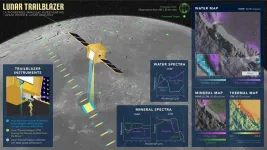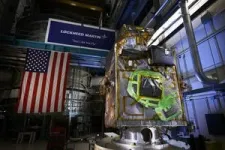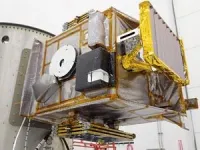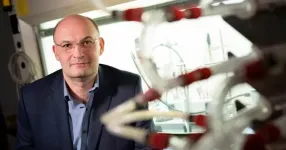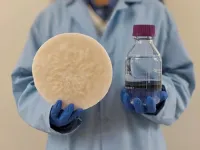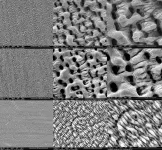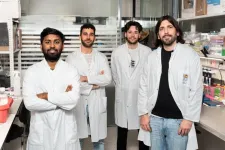(Press-News.org) On Wednesday 26 February, a thermal imaging camera built by researchers at the University of Oxford’s Department of Physics will blast off to the Moon as part of NASA’s Lunar Trailblazer mission. This aims to map sources of water on the Moon to shed light on the lunar water cycle and to guide future robotic and human missions.
Once in orbit, the spacecraft – weighing 200kg and about the size of a washing machine- will map the surface temperature and composition of the lunar surface 12 times a day, at a resolution of 50 metres. Using cutting-edge instruments, it will examine features including the permanently shadowed craters at the Moon's South Pole, which could contain significant quantities (potentially 600 million metric tons) of water ice. This could be used in various ways, from purifying it as drinking water to processing it for fuel and breathable oxygen for future human Moon landings.
One of the two principal instruments, the Lunar Thermal Mapper (LTM), was constructed by researchers in the Planetary Experiments Group at the University of Oxford’s Department of Physics. This will measure the surface temperature and the various minerals that make up the lunar landscape, to help confirm the presence and location of water. The instrument will work in tandem with NASA/JPL’s High-resolution Volatiles and Minerals Moon Mapper (HVM3) to produce the most detailed maps of water on the Moon's surface to date. (Further details on how the instruments work below)
Lunar Trailblazer was selected by NASA’s Small Innovative Missions for Planetary Exploration (SIMPLEx) program in 2019, which provides opportunities for low-cost science spacecraft to ride-share with selected primary missions. The spacecraft will launch as a secondary payload on a planned lunar lander mission led by Intuitive Machines, effectively hitchhiking on the larger spacecraft, which will attempt a soft landing on the Moon. If the launch at NASA’s Kennedy Space Center, Florida, goes smoothly, the first images from the LTM should arrive back on earth within three days.
Since the spacecraft has a relatively small engine, its planned trajectory will use the gravity of the Sun, Earth, and Moon to guide it to the final orbit — a technique called low-energy transfer. The momentum provided by the rocket booster will propel the spacecraft past the Moon and into deep space before it is pulled back by gravity. The spacecraft will then use small thruster bursts to slowly correct its orbit until it is about 60 miles (100 kilometers) above the Moon’s surface. In all, Lunar Trailblazer should take between four and seven months to arrive in its final orbit.
The LTM was constructed by the Planetary Experiments Group at the University of Oxford’s Department of Physics, with £3.1 million funding from the UK Space Agency and the Department for Science, Innovation and Technology (DSIT). For the group, building the LTM is the latest achievement in a 50-year history of developing components for spaceflight and infrared thermal mapping cameras, including for missions to Mars, Saturn, and the Moon. With the LTM’s components being produced by various UK academic institutes and companies (details below), this collective effort highlights the nation's leading role in space exploration and scientific research.
Professor Neil Bowles, Instrument Scientist for LTM at the University of Oxford’s Department of Physics, said:
“The Lunar Thermal Mapper was designed, built and tested here in Oxford and the launch is an important moment for the whole of our team. The measurements of temperature will help confirm the presence of the water signal in HVM3’s measurements and the two instruments will work together to map the composition of the Moon, showing us details that have only been hinted at previously.”
The mission could also reveal why the Moon has water in the first place. Possible reasons include comets and ‘wet asteroids’ crashing into the Moon; ancient volcanic eruptions disgorging water vapor from the Moon’s interior; or hydrogen within the solar wind combining with oxygen on the Moon. Lunar Trailblazer's findings will shed light on which hypothesis is more likely.
Lauren Taylor, Major Projects Lead from The UK Space Agency said:
"The UK Space Agency is thrilled to be a part of NASA's Lunar Trailblazer mission. Our work with the University of Oxford to develop the Lunar Thermal Mapper showcases the UK's leading role in space exploration and scientific research.
“This mission will provide invaluable data on the Moon's water resources, supporting future human missions and enhancing our understanding of the lunar environment.”
Notes to editors
For media requests and interviews, contact Caroline Wood: caroline.wood@admin.ox.ac.uk
Many images related to the mission are available here (must be credited): https://trailblazer.caltech.edu/gallery.html
https://flickr.com/photos/lockheedmartin/albums/72177720305810321/with/52673223964
Further information can be found on the Lunar Trailblazer website: https://trailblazer.caltech.edu/
To receive the press pack for the mission, with further graphics and diagrams, contact Caroline Wood: caroline.wood@admin.ox.ac.uk
The most up-to-date information about Lunar Trailblazer mission media events and where to watch them is available at nasa.gov/multimedia/nasatv/schedule.html News briefings and launch commentary will be streamed on NASA TV, NASA.gov/live, and YouTube.com/NASA. On-demand recordings will also be available on YouTube after the live events have finished.
Further detail on how the Lunar Thermal Mapper works:
The two instruments on the Lunar Trailblazer spacecraft - the Lunar Thermal Mapper (LTM) and High-resolution Volatiles and Minerals Moon Mapper (HVM3) will work in tandem to generate high-resolution maps of the Moon’s water to help determine the Moon’s water cycle.
The Oxford-built LTM will use four broadband infrared channels to measure the temperature of the lunar surface ranging from approximately -163°C to 127°C. The instrument will also use eleven narrow infrared channels to map small variations in the composition of silicate minerals that make up the rocks and soils of the Moon’s surface. This will provide more information about what the lunar surface is made of and where water may potentially be found.
Meanwhile, the HVM3 (built by NASA’s Jet Propulsion Laboratory and funded by NASA) will detect and map the form, abundance, and locations of water over the lunar landscape by measuring spectral fingerprints (wavelengths of reflected sunlight). The temperature of the surface being measured affects the apparent strength of the absorption signal of water, therefore the HVM3 spectral data will be calibrated using the temperature measurements recorded at the same time by the LTM.
By mapping the Moon day and night, Lunar Trailblazer will be able to detect whether the amount of water changes on this airless body, for instance, by transforming into a gas as the surface heats up, or accumulating like frost in the shadowed regions as the surface cools down. The mission will help answer key questions such as whether water molecules might be locked up inside lunar rock, or if the permanently shadowed craters at the lunar poles hold significant quantities of water ice.
The UK’s contribution to NASA’s Lunar Trailblazer mission:
The Lunar Trailblazer mission is led by Principal Investigator Professor Bethany Ehlmann at the California Institute of Technology (Caltech) and managed by NASA’s Jet Propulsion Laboratory in Southern California. The LTM was designed, built, and tested by the Department of Physics, University of Oxford, with optics manufactured by Durham University’s Centre for Advanced Instrumentation and far infrared filters supplied by the University of Cardiff and specialist manufacturers based across the UK. Support for electronics and software design early in the project was provided by RAL Space.
About the University of Oxford
Oxford University has been placed number 1 in the Times Higher Education World University Rankings for the ninth year running, and number 3 in the QS World Rankings 2024. At the heart of this success are the twin-pillars of our ground-breaking research and innovation and our distinctive educational offer.
Oxford is world-famous for research and teaching excellence and home to some of the most talented people from across the globe. Our work helps the lives of millions, solving real-world problems through a huge network of partnerships and collaborations. The breadth and interdisciplinary nature of our research alongside our personalised approach to teaching sparks imaginative and inventive insights and solutions.
Through its research commercialisation arm, Oxford University Innovation, Oxford is the highest university patent filer in the UK and is ranked first in the UK for university spinouts, having created more than 300 new companies since 1988. Over a third of these companies have been created in the past five years. The university is a catalyst for prosperity in Oxfordshire and the United Kingdom, contributing £15.7 billion to the UK economy in 2018/19, and supports more than 28,000 full time jobs.
END
Lunar Trailblazer blasts off to map water on the moon
2025-02-25
ELSE PRESS RELEASES FROM THIS DATE:
Beacon Technology Solutions, Illinois Tech awarded grant to advance far-UVC disinfection research
2025-02-25
CHICAGO—February 24, 2025—Beacon Technology Solutions (Beacon), with collaborators at Illinois Institute of Technology (Illinois Tech), has been awarded a grant to support a novel study on how Far-UVC technology can help mitigate the spread of infectious diseases in public spaces. The grant was awarded through the Illinois Innovation Vouchers (IIV) Program, which fosters research collaborations between small- and medium-sized enterprises and Illinois’ world-class universities.
Beacon’s flagship product is a wall-mounted smart disinfection device that uses Far-UVC 222nm light, which has been shown to disinfect up to 99.99 percent ...
University of Houston researchers paving the way for new era in medical imaging
2025-02-25
New technology developed by researchers at the University of Houston could revolutionize medical imaging and lead to faster, more precise and more cost-effective alternatives to traditional diagnostic methods.
For years, doctors have relied on conventional 2D X-rays to diagnose common bone fractures, but small breaks or soft tissue damage like cancers often go undetected. More expensive and time-consuming MRI scans are not always suitable for these tasks in these detection or screening settings. Now, Mini Das, Moores professor at UH’s College of Natural Sciences and Mathematics and Cullen College ...
High-tech startup CrySyst provides quality-by-control solutions for pharmaceutical, fine chemical industries
2025-02-25
WEST LAFAYETTE, Ind. — International process systems and operation experts have launched high-tech startup Crystallization Systems Technology Inc. (CrySyst) to streamline processes used by companies in the pharmaceutical and fine chemical industries.
CrySyst’s quality-by-control (QbC) framework addresses crystallization monitoring, modeling and control. The framework is based on research published in the April 15, 2020, and Oct. 5, 2021, issues of the journal Crystal Growth & Design and the Sept. 22, 2022, issue of the journal Industrial & Engineering ...
From scraps to sips: Everyday biomass produces drinking water from thin air
2025-02-25
Discarded food scraps, stray branches, seashells and many other natural materials are key ingredients in a new system that can pull drinkable water out of thin air developed by researchers from The University of Texas at Austin.
This new “molecularly functionalized biomass hydrogels” system can convert a wide range of natural products into sorbents, materials that absorb liquids. By combining these sorbents with mild heat, the researchers can harvest gallons of drinkable water out of the atmosphere, even in dry conditions.
“With ...
Scientists design novel battery that runs on atomic waste
2025-02-25
COLUMBUS, Ohio – Researchers have developed a battery that can convert nuclear energy into electricity via light emission, a new study suggests.
Nuclear power plants, which generate about 20% of all electricity produced in the United States, produce almost no greenhouse gas emissions. However, these systems do create radioactive waste, which can be dangerous to human health and the environment. Safely disposing of this waste can be challenging.
Using a combination of scintillator crystals, high-density materials that emit light when they absorb radiation, and solar cells, the team, led by researchers from The Ohio State University, demonstrated that ambient ...
“Ultra-rapid” testing unlocks cancer genetics in the operating room
2025-02-25
A novel tool for rapidly identifying the genetic “fingerprints” of cancer cells may enable future surgeons to more accurately remove brain tumors while a patient is in the operating room, new research reveals. Many cancer types can be identified by certain mutations, changes in the instructions encoded in the DNA of the abnormal cells.
Led by a research team from NYU Langone Health, the new study describes the development of Ultra-Rapid droplet digital PCR, or UR-ddPCR, which the team found can measure the level of tumor cells in a tissue sample ...
Mimicking shark skin to create clean cutting boards
2025-02-25
WASHINGTON, Feb. 25, 2025 – Keeping work surfaces clean during meat processing is a challenge. Bacteria from meat can attach, grow, and build up to create a biofilm that is difficult to remove, even on stainless steel surfaces used in industrial facilities. It can also aggregate, clumping together into an invisible mass that is stronger than individual cells, making it harder to kill using food-grade antibacterial surface cleaners.
In a paper published this week in Journal of Laser Applications, from AIP Publishing and the Laser Institute of America, researchers from the Hopkirk Research Institute, New Zealand Food Safety Science and Research Centre, ...
Adherence to the Mediterranean diet and obesity-linked cancer risk
2025-02-25
About The Study: The findings of this study indicate that higher adherence to the Mediterranean diet is associated with a modest reduction in the risk of obesity-related cancers, independent of adiposity measures. Further research is needed to clarify the mechanisms by which the Mediterranean diet may contribute to cancer prevention.
Corresponding Author: To contact the corresponding author, Inmaculada Aguilera-Buenosvinos, PhD, email iaguilerabuenosvinos@gmail.com.
To access the embargoed study: Visit our For The Media website at this link https://media.jamanetwork.com/
(doi:10.1001/jamanetworkopen.2024.61031)
Editor’s Note: Please see the ...
New technique reveals how the same mutations give rise to very different types of leukaemia
2025-02-25
Barcelona, 25 February 2025 - Myeloid leukaemias are among the most aggressive blood cancers and have low survival rates. Today, leukaemia patients undergo genetic analysis to identify mutations and select the most appropriate treatment. However, even among patients with the same mutation, disease progression and response to therapy can vary significantly.
A study led by ICREA researcher Dr. Alejo Rodríguez-Fraticelli at IRB Barcelona, and funded by Fundación CRIS contra el cáncer, has now revealed these differences can be explained by the fact that not all blood stem cells ...
New insights into how gut cells respond to bacterial toxins
2025-02-25
Researchers from the Organoid group at the Hubrecht Institute have found that specific gut cells, BEST4/CA7+ cells, regulate electrolyte and water balance in response to bacterial toxins that cause diarrhea. Their findings, published in Cell Stem Cell, show that these cells greatly increase in number when exposed to the cytokine interferon-γ (IFNγ), presenting a promising target for therapeutic strategies.
In the gut, a variety of cell types collaborate to keep a balance of electrolyte and water. Bacterial infections can disrupt this balance, leading ...
